Invisalign® Clear Aligners – Bloomfield, CT
Subtle Treatment, Dramatic Results
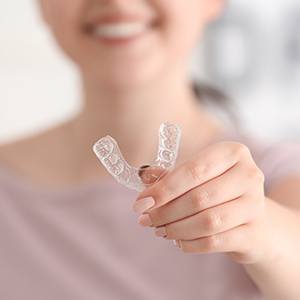
For years, traditional metal braces were the only option to correct crooked, gapped, or crowded teeth. While traditional braces are effective, they are no longer the only bite correction option available. Clear braces like Invisalign® clear aligners from our Bloomfield, CT orthodontist make it possible to shift your teeth without the pain, hassle and mouth full of metal associated with traditional braces.
Why Choose Family Dental Practice of Bloomfield for Invisalign® Clear Aligners?
- On-Staff Orthodontist
- Convenient Appointment Times
- Personalized Support Throughout Your Treatment
How It Works
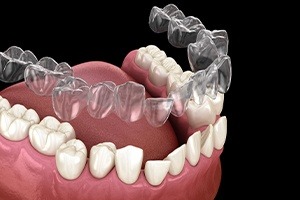
Traditional braces comprise a series of brackets fused to teeth that are connected to other brackets using wires. These wires are then tightened, causing your teeth to shift into alignment. Invisalign® uses the same basic idea of constant pressure to move your bite into proper alignment. However, instead of using brackets and wires, pressure is applied by the clear alignment trays. Many patients report experiencing less pain with Invisalign®. At Family Dental Practice of Bloomfield, our Invisalign® trained dentists will examine your current bite and develop alignment trays to be worn and discarded about every two weeks. These trays are customized to correct your bite, and your dentist can explain how your alignment trays will shift your bite using our advanced technology. Most patients complete their Invisalign® treatment in about a year.
The Invisalign® Difference
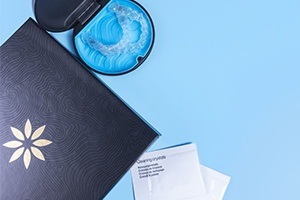
In just 12 months, your teeth maybe be perfectly aligned, but in the meantime, you will not have to worry about changing your diet or attending frequent dental appointments. Because clear braces are removable, you can take them out for meals and replace them after. They can even be taken out during photos or important events. Skipping school to go to the orthodontist might have been something to look forward to, but for many working adults, this is not an option. Patients who choose Invisalign® require less than half the number of dentist visits throughout their course of treatment.
Who Can Invisalign Help?

Invisalign is a suitable treatment for most cases of mild to moderate dental misalignment. When you visit us for a consultation, our team will evaluate the positioning of your teeth and your oral health before we can determine if Invisalign is right for you. Are you curious about some of the specific misalignment issues that clear aligners are often used to correct? Here are a few examples:
Crowded Teeth
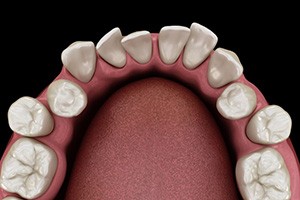
Crowded and crooked teeth can trap food and bacteria between them, leading to a heightened risk of issues like decay, gum disease, and bad breath. They can also have an adverse effect on your facial aesthetics. Additionally, they may be at an increased risk of breakage because they hit one another at odd angles. Invisalign, sometimes after strategic tooth extractions, is often able to correct overcrowding and lead to improved oral and overall health.
Gaps Between Teeth

Gaps between the teeth can make you feel self-conscious about your appearance. They also leave your gum tissue vulnerable to harm. Over the course of several months, Invisalign clear aligners may be able to shift your teeth so they are closer together, leading to improved aesthetics and fewer oral health risks.
Overbite
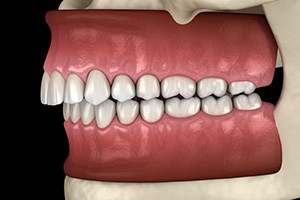
A bit of an overbite is both normal and healthy. However, if the upper teeth rest too far in front of the lower teeth, significant complications can result. For example, you might experience jaw pain, difficulty closing and opening your mouth, and uneven wear and tear on your teeth. Invisalign, usually with the help of special accessories, can often correct cases of overbite.
Underbite

If your bottom teeth rest in front of your top teeth, you have a type of malocclusion (bad bite) known as an underbite. This can affect your appearance, your speech, and your risk of numerous oral health conditions. Invisalign may be able to shift your teeth and work with accessories to train your lower jaw to rest in the correct position. As a result, your underbite may be completely corrected.
Crossbite
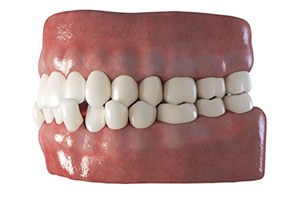
A crossbite occurs when only some of the bottom teeth rest in front of the top teeth. This issue can lead to speech issues, jaw pain, broken teeth, and other unpleasant consequences. Fortunately, Invisalign clear aligners are usually able to correct cases of crossbite and lead to improved oral health and function.
Open Bite
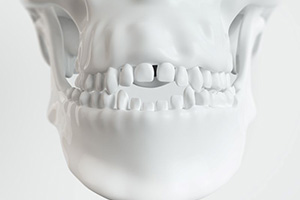
If there is a vertical gap between your top and bottom front teeth, even when your back teeth are touching one another, you have an open bite. This issue can interfere with your ability to bite and speak with confidence. Invisalign may be able to close an open bite.
Benefits of Invisalign

When you start to understand the many benefits of Invisalign, it becomes easy to see why this treatment is so popular! It is designed for maximum convenience and confidence — all without compromising effectiveness or efficiency. Would you like to learn how Invisalign might be able to have a positive effect on your life? Below, you will find some specific benefits that you are likely to experience during your treatment period.
Comfortable Aligner Trays
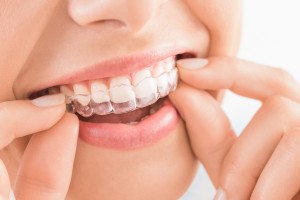
Invisalign aligners are constructed of a patented plastic material that is designed to rest comfortably against the soft oral tissues in the mouth. Unlike traditional metal braces, there are no metal brackets and wires to irritate your tongue and cheeks.
(Of course, it must be noted that the trays still apply pressure to the teeth, which can lead to mild discomfort. Often, over-the-counter pain medications can keep this issue under control.)
A Discreet Appearance

If the idea of having metal brackets and wires in your mouth is unappealing, you are far from alone. Traditional braces make many people feel self-conscious about their appearance. The good news is that Invisalign trays are very discreet. Although they are not totally invisible, they do not draw a lot of attention to themselves. Plus, you can remove them for special occasions, such as photoshoots.
Easier Dental Hygiene

Oral hygiene can be a bit challenging with traditional braces; navigating around all those brackets and wires takes time and effort! With Invisalign, it is easier to maintain a fresh and clean mouth. All you have to do is remove your aligners and brush and floss as normal. Cleaning the aligners is also easy and takes very little time each day.
Quick Follow-Ups

It is standard for patients to attend Invisalign checkups every 6 – 8 weeks or so. Most of the time, these appointments are very brief; they may take just 15 – 30 minutes or so. We simply check on your progress, provide you with the next set of aligners in your series, and send you on your way to continue with your treatment.
No Dietary Restrictions

While wearing your aligners, the only thing you should consume is plain water. However, when you remove your aligners at mealtimes, you can enjoy whatever foods you want! You can even indulge in items that are off-limits with regular braces, like pizza crusts and gummy candies. (Of course, you should always enjoy sugary and starchy treats in moderation.)
A Treatment That Works with Your Lifestyle

Whether you are a teen or an adult, Invisalign is designed to work with your busy lifestyle. The clear trays can lend you increased confidence, the quick appointments can fit into your schedule, and the overall convenience of treatment can make it easier to plan your daily activities. Invisalign is truly a treatment for the modern world!
Living with Invisalign Aligners

Just like any orthodontic treatment, Invisalign will require you to make some changes to your daily routine. Complying with guidelines will minimize your risk of complications and help to keep your tooth movements on track! What are some specific things you will have to do when you are living with Invisalign aligners? Our team will give you personalized tips when you visit us. In the meantime, you can gain some valuable information by reviewing the information listed below.
Wearing Your Trays

You should wear your aligners for 20 – 22 hours each day (the closer to 22 hours, the better). Failing to meet your daily wear time could slow down the movements of your teeth, which could delay your final results and increase your discomfort when you transition to a new set of aligners. As a basic rule of thumb, your aligner trays should only be out of your mouth when you are eating, drinking anything other than plain water, or caring for your oral hygiene.
Cleaning Your Aligners
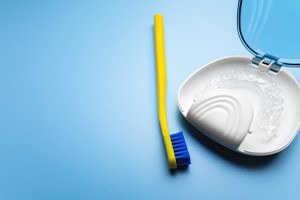
You should rinse your aligners after each meal to remove saliva and other debris. You should also thoroughly clean them at least once a day. Use a soft-bristled brush and mild, clear soap to gently scrub all their surfaces. You should also soak them regularly; many patients choose to use Invisalign cleaning crystals for this.
Keeping your teeth clean is important for your success with Invisalign. It is best to brush and floss after each meal.
Eating & Drinking

One of the biggest perks of Invisalign is that the aligners are removable. Simply take your trays out of your mouth, enjoy whatever food you are craving, take care of your oral hygiene, and put Invisalign back on your teeth.
Keep in mind that the only thing you should consume while wearing Invisalign is plain water. Eating or drinking anything else could damage your trays. For example, hot foods and beverages could warp them, whereas pigmented items could cause them to become discolored.
Losing or Damaging a Tray

If one of your aligners becomes unusable because it is damaged or misplaced, you should address the situation as soon as possible. Otherwise, your treatment could easily get off track. Call our office and let us know what happened. We might advise you to go back to wearing a previous aligner until we can order a replacement for the one that got lost. Or, we might tell you to move on to your next aligner a few days early.
Routine Check-Ins

Every 4 – 8 weeks, you should visit us for a routine check-in. These appointments are usually brief (maybe 15 minutes or so). We will simply check on your progress, address any concerns that might have arisen since your last visit, and provide you with the next set of aligners in your series. If we ever discover that your treatment plan needs to be adjusted, you can expect a longer appointment as we make any necessary changes.
Understanding the Cost of Invisalign
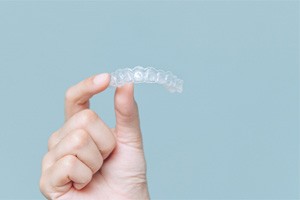
The cost of Invisalign in Bloomfield depends on various factors; during your consultation, we will be able to provide you with a personalized price estimate. For most patients, start-to-finish treatment costs at least a few thousand dollars. Fortunately, our practice offers convenient provisions that may make it easier for you to fit Invisalign into your budget.
Factors that Affect the Cost of Invisalign
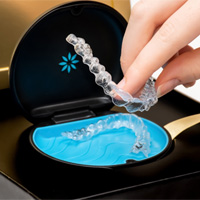
The primary factor that influences the cost of Invisalign is the number of aligners you will need. This depends mostly on the extent of your dental misalignment; logically, more severe problems will require more aligners and more time to correct. Other relevant factors include whether you are straightening one dental arch or both, whether you have any mishaps that will require you to purchase replacement aligners, the complexity of the desired tooth movements, and whether you will need any special accessories to correct a bad bite or complex orthodontic issues.
Invisalign vs. Mail-Order Clear Aligners: Comparing Your Options
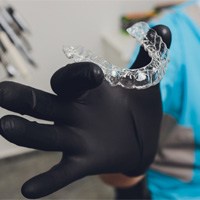
In recent years, mail-order clear aligners have seen a boom in popularity. The trend is understandable. Most mail-order treatments cost around $2,000 for start-to-finish care, while Invisalign and other forms of in-office aligner services tend to have a significantly higher price tag.
Before you commit to anything, though, you should consider what you are getting for your money. With Invisalign, you will enjoy:
- Personalized support from a local team who cares deeply about the success of your treatment
- Treatment methods that have a longstanding track record of success
- Aligners made out of a smooth, patented plastic material
Mail-order aligners lack the advantages listed above. Many patients have experienced unsatisfactory results from them, and in some cases, they have seen their dental misalignment become worse! Afterward, they have spent significant amounts of money on correcting new or exacerbated problems with their smile. It would be wise to invest in professional, in-person treatment right from the start.
Does Dental Insurance Cover Invisalign?

Some higher-end dental insurance policies include a once-in-a-lifetime provision for orthodontic care. Often, Invisalign in Bloomfield is covered at around 50% by such plans, up to the amount of the plan’s orthodontic maximum. However, you will have to check the details of your unique benefits to know if and how they apply. If your insurance does not cover Invisalign, you might be able to reduce your out-of-pocket costs by using your flexible spending account or healthcare savings account.
Options for Making Invisalign Affordable

As your Invisalign dentist in Bloomfield, we are ready to do what we can to help you afford your care. Some provisions that you might be able to take advantage of include:
- Many patients qualify for a low-interest payment plan through CareCredit. The application process is fast, and you may be able to choose a monthly payment amount that fits your budget.
- We periodically offer special pricing on Invisalign treatment and consultations. Call us to ask if we have any current promotions that you could use.
Are you ready to learn more about Invisalign and its cost? Contact us today to find out how we might be able to help you achieve straighter teeth without breaking your budget.
Invisalign FAQs
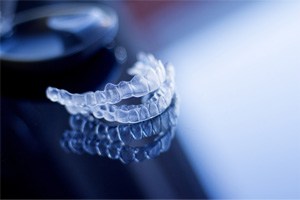
For many patients, Invisalign is the ideal way to correct dental misalignment. However, we understand if you want to gather as much information about it as possible before you commit to anything. To assist you, we have compiled the following list of Invisalign FAQs, along with succinct answers. If you do not see your specific question addressed, reach out directly to our team. We are eager to speak with you!
How Long Does Invisalign Take?
The average treatment timeline with Invisalign is 12 months. However, your case may take significantly more or less time. Mild cases of dental misalignment may require just 6 months or so of treatment, whereas more complex cases could take up to 18 months or longer to correct. During your consultation, we will be able to provide you with an estimate for how long your Invisalign will take.
Keep in mind that although 18 months can seem like a long time, you are still likely to enjoy shorter treatment than if you got traditional braces instead.
Does Invisalign Hurt?
Invisalign aligners are constructed out of a smooth plastic material that is designed to rest as comfortably as possible against the oral tissues. There are no metal brackets or wires to irritate your cheeks, lips, or tongue.
However, keep in mind that Invisalign works by applying pressure to the teeth. Naturally, that can cause some discomfort. Your mouth may be particularly sore when you first start using a new aligner. Taking pain relievers, sipping on cool water, and switching to a new aligner at night (so you can sleep through the first part of the adjustment period) can help you to adjust with minimal pain.
What Happens After Invisalign?
After you work your way through all of your aligners, you will need to maintain your results. Our team will provide you with a retainer, which you should wear for 20 – 22 hours each day. It will prevent your teeth from drifting back out of place. Eventually, as your teeth solidify into their new positions, you may be able to wear it just a few nights each week.
What if My Invisalign Broke?
If an aligner has some hairline cracks, you might be able to continue using it. You will just have to take extra precautions when you are taking it in and out of your mouth so you do not accidentally worsen the damage.
If an aligner is badly damaged, do not attempt to wear it, and do not try to repair it on your own. Instead, give our team a call. We might advise you to go back to wearing a previous aligner while we order a replacement for the broken one. In other instances, we might tell you to switch to a new aligner a bit early. (Never move on to a new aligner sooner than expected unless your dentist explicitly told you to do so. Moving on too early could cause significant oral soreness.)
